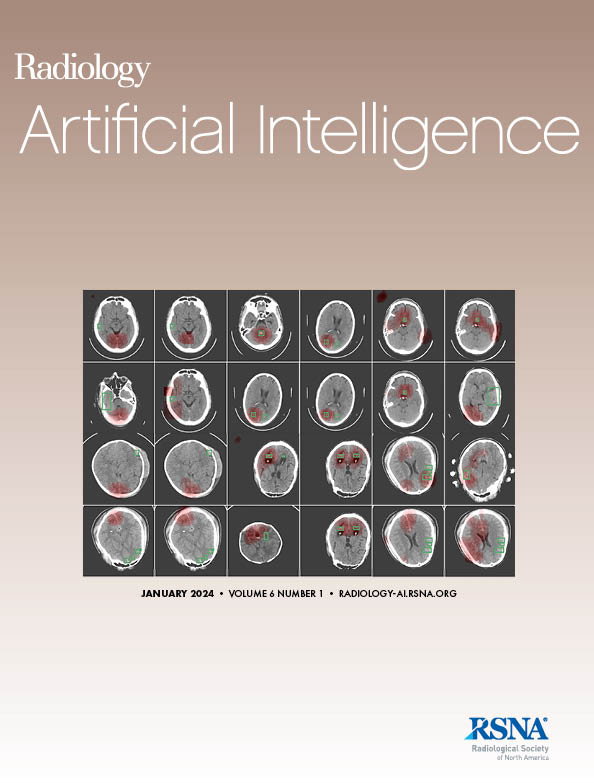Mohammad-Kasim Fassia, Adithya Balasubramanian, Sungmin Woo, Hebert Alberto Vargas, Hedvig Hricak, Ender Konukoglu, Anton S Becker
下载PDF
{"title":"深度学习前列腺 MRI 分段准确性和鲁棒性:系统性综述。","authors":"Mohammad-Kasim Fassia, Adithya Balasubramanian, Sungmin Woo, Hebert Alberto Vargas, Hedvig Hricak, Ender Konukoglu, Anton S Becker","doi":"10.1148/ryai.230138","DOIUrl":null,"url":null,"abstract":"<p><p>Purpose To investigate the accuracy and robustness of prostate segmentation using deep learning across various training data sizes, MRI vendors, prostate zones, and testing methods relative to fellowship-trained diagnostic radiologists. Materials and Methods In this systematic review, Embase, PubMed, Scopus, and Web of Science databases were queried for English-language articles using keywords and related terms for prostate MRI segmentation and deep learning algorithms dated to July 31, 2022. A total of 691 articles from the search query were collected and subsequently filtered to 48 on the basis of predefined inclusion and exclusion criteria. Multiple characteristics were extracted from selected studies, such as deep learning algorithm performance, MRI vendor, and training dataset features. The primary outcome was comparison of mean Dice similarity coefficient (DSC) for prostate segmentation for deep learning algorithms versus diagnostic radiologists. Results Forty-eight studies were included. Most published deep learning algorithms for whole prostate gland segmentation (39 of 42 [93%]) had a DSC at or above expert level (DSC ≥ 0.86). The mean DSC was 0.79 ± 0.06 (SD) for peripheral zone, 0.87 ± 0.05 for transition zone, and 0.90 ± 0.04 for whole prostate gland segmentation. For selected studies that used one major MRI vendor, the mean DSCs of each were as follows: General Electric (three of 48 studies), 0.92 ± 0.03; Philips (four of 48 studies), 0.92 ± 0.02; and Siemens (six of 48 studies), 0.91 ± 0.03. Conclusion Deep learning algorithms for prostate MRI segmentation demonstrated accuracy similar to that of expert radiologists despite varying parameters; therefore, future research should shift toward evaluating segmentation robustness and patient outcomes across diverse clinical settings. <b>Keywords:</b> MRI, Genital/Reproductive, Prostate Segmentation, Deep Learning Systematic review registration link: osf.io/nxaev © RSNA, 2024.</p>","PeriodicalId":29787,"journal":{"name":"Radiology-Artificial Intelligence","volume":" ","pages":"e230138"},"PeriodicalIF":8.1000,"publicationDate":"2024-07-01","publicationTypes":"Journal Article","fieldsOfStudy":null,"isOpenAccess":false,"openAccessPdf":"https://www.ncbi.nlm.nih.gov/pmc/articles/PMC11294957/pdf/","citationCount":"0","resultStr":"{\"title\":\"Deep Learning Prostate MRI Segmentation Accuracy and Robustness: A Systematic Review.\",\"authors\":\"Mohammad-Kasim Fassia, Adithya Balasubramanian, Sungmin Woo, Hebert Alberto Vargas, Hedvig Hricak, Ender Konukoglu, Anton S Becker\",\"doi\":\"10.1148/ryai.230138\",\"DOIUrl\":null,\"url\":null,\"abstract\":\"<p><p>Purpose To investigate the accuracy and robustness of prostate segmentation using deep learning across various training data sizes, MRI vendors, prostate zones, and testing methods relative to fellowship-trained diagnostic radiologists. Materials and Methods In this systematic review, Embase, PubMed, Scopus, and Web of Science databases were queried for English-language articles using keywords and related terms for prostate MRI segmentation and deep learning algorithms dated to July 31, 2022. A total of 691 articles from the search query were collected and subsequently filtered to 48 on the basis of predefined inclusion and exclusion criteria. Multiple characteristics were extracted from selected studies, such as deep learning algorithm performance, MRI vendor, and training dataset features. The primary outcome was comparison of mean Dice similarity coefficient (DSC) for prostate segmentation for deep learning algorithms versus diagnostic radiologists. Results Forty-eight studies were included. Most published deep learning algorithms for whole prostate gland segmentation (39 of 42 [93%]) had a DSC at or above expert level (DSC ≥ 0.86). The mean DSC was 0.79 ± 0.06 (SD) for peripheral zone, 0.87 ± 0.05 for transition zone, and 0.90 ± 0.04 for whole prostate gland segmentation. For selected studies that used one major MRI vendor, the mean DSCs of each were as follows: General Electric (three of 48 studies), 0.92 ± 0.03; Philips (four of 48 studies), 0.92 ± 0.02; and Siemens (six of 48 studies), 0.91 ± 0.03. Conclusion Deep learning algorithms for prostate MRI segmentation demonstrated accuracy similar to that of expert radiologists despite varying parameters; therefore, future research should shift toward evaluating segmentation robustness and patient outcomes across diverse clinical settings. <b>Keywords:</b> MRI, Genital/Reproductive, Prostate Segmentation, Deep Learning Systematic review registration link: osf.io/nxaev © RSNA, 2024.</p>\",\"PeriodicalId\":29787,\"journal\":{\"name\":\"Radiology-Artificial Intelligence\",\"volume\":\" \",\"pages\":\"e230138\"},\"PeriodicalIF\":8.1000,\"publicationDate\":\"2024-07-01\",\"publicationTypes\":\"Journal Article\",\"fieldsOfStudy\":null,\"isOpenAccess\":false,\"openAccessPdf\":\"https://www.ncbi.nlm.nih.gov/pmc/articles/PMC11294957/pdf/\",\"citationCount\":\"0\",\"resultStr\":null,\"platform\":\"Semanticscholar\",\"paperid\":null,\"PeriodicalName\":\"Radiology-Artificial Intelligence\",\"FirstCategoryId\":\"1085\",\"ListUrlMain\":\"https://doi.org/10.1148/ryai.230138\",\"RegionNum\":0,\"RegionCategory\":null,\"ArticlePicture\":[],\"TitleCN\":null,\"AbstractTextCN\":null,\"PMCID\":null,\"EPubDate\":\"\",\"PubModel\":\"\",\"JCR\":\"Q1\",\"JCRName\":\"COMPUTER SCIENCE, ARTIFICIAL INTELLIGENCE\",\"Score\":null,\"Total\":0}","platform":"Semanticscholar","paperid":null,"PeriodicalName":"Radiology-Artificial Intelligence","FirstCategoryId":"1085","ListUrlMain":"https://doi.org/10.1148/ryai.230138","RegionNum":0,"RegionCategory":null,"ArticlePicture":[],"TitleCN":null,"AbstractTextCN":null,"PMCID":null,"EPubDate":"","PubModel":"","JCR":"Q1","JCRName":"COMPUTER SCIENCE, ARTIFICIAL INTELLIGENCE","Score":null,"Total":0}
引用次数: 0
引用
批量引用

 求助内容:
求助内容: 应助结果提醒方式:
应助结果提醒方式:


